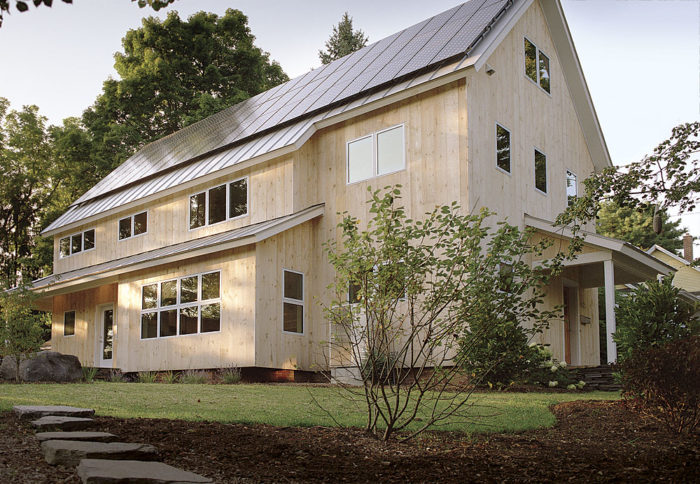
Image Credit: Ethan Drinker
Sara and Gareth Ross had spent a decade on the move. Postgraduate degrees and finance work had propelled them from Boston to New York, Philadelphia, and San Francisco. When it came time to settle down, though, they moved to Amherst, Mass., where Sara had grown up. Amherst is a vibrant college town with rural beauty and Japanese restaurants; for the Rosses, it was the perfect place to slow down, nurture roots, and raise children. The Rosses were not tied either to the idea of a new house or to a remodel. Instead, their vision centered on creating a healthful, durable, and energy-efficient home.
Location was the most important criterion
While they searched for the right plot of land or a perfect rehab opportunity, Sara and Gareth rented a three-bedroom house in town. It was within walking distance of everything: a bakery that saved the Financial Times for Gareth every morning, a school with swings for kids, and a string of restaurants, bars, and coffee shops. They fell in love with the neighborhood. When they heard that the house next door was going up for sale, they eagerly made an offer, completed the sale, and became quickly and firmly committed to an extensive renovation project.
Built in the 1880s, the house had suffered years of deferred maintenance: The roof was failing, the chimney needed work, most of the exterior was covered in asbestos siding, the walls were barely insulated, and the furnace was 40 years old. In other words, it was the perfect candidate for a deep-energy retrofit.
The interior spaces were not much better. Small rooms on the main floor provided lots of privacy, but these areas were begging for openness. This is a common problem when updating an old house. For example, kitchens used to be tucked away in the…
Weekly Newsletter
Get building science and energy efficiency advice, plus special offers, in your inbox.

This article is only available to GBA Prime Members
Sign up for a free trial and get instant access to this article as well as GBA’s complete library of premium articles and construction details.
Start Free TrialAlready a member? Log in















4 Comments
blower door test
When is the best time during renovation to have this test done? We're about to start a renovation, new roof, siding, windows, kitchen etc and are going all electric too. thanks
Do the first blower door test
Do the first blower door test before you start, both to get a benchmark and to find out where the problems lie. Then have one done when you complete framing, after the new windows are installed and prior to insulation - this is the last chance to seal the envelope easily. Then one at completion.
The cost of rooftop solar in 2015...
... is about half what it was in 2010/2011 when they installed theirs, ~$3.50/watt vs ~$7/watt. After the tax & other subsidy their circa 2010 system still has a lifecycle cost well below current grid-retail, but at 2015 pricing it's about half (even before factoring in any subsidies). And the savings are in after-tax dollars!
With only 3" of polyiso (R18) outside the roof deck it limits the interior side fiber layer to about R27 before an interior side vapor retarder would be required, which is a few R shy of the IRC 2012 code min of R49. In the photo it looks like there is some open cell polyurethane applied to the roof deck ( or was that just a big gob of can-foam?). What was the actual interior-side R & type, and what (if anything) was done to adjust the interior side vapor retardency?
Thank you Bob Irving
The info you provided is very useful.....cant wait to hear what the contractor thinks :)
Log in or become a member to post a comment.
Sign up Log in